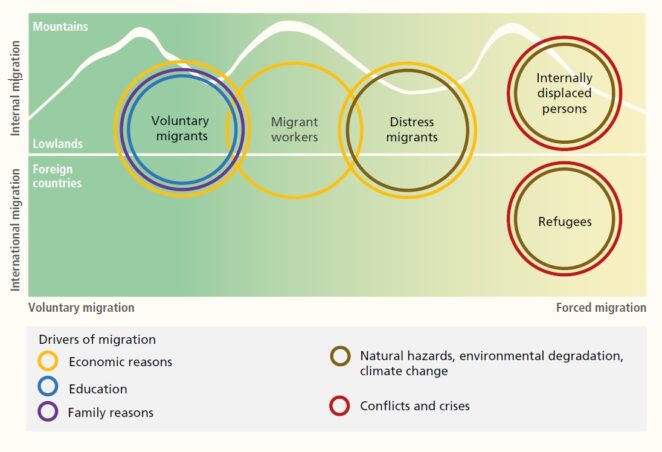Article /
Migration and Sustainable Mountain Development – Turning Challenges into Opportunities

Introduction
People living in mountain areas have long used migration as a strategy to make optimal use of natural resources, ensure food security, strengthen their social and economic networks, and fulfil personal aspirations. Even today, migration continues to be an adaptive response to environmental, societal, economic and political pressure. Experience from around the world shows that labour migration can help to reduce poverty and diversify livelihoods in mountains and beyond, but its success is determined by several factors. Which member of the household is migrating and under what conditions, and how effective is the transfer, management and investment of remittances?
This publication, part of the Sustainable Mountain Development Series, focuses on the situation in rural areas, where about 70 percent of mountain people still live. It seeks to provide insights into the complex migration processes and the resulting opportunities and challenges for mountain communities and regions. It also presents a selection of good practices that contribute to sustainable development in rural mountain regions, either by reducing people’s distress at leaving the mountains or by facilitating positive outcomes of migration. The publication concludes with a set of policy messages that outline how migration can be integrated into policy and decision-making effectively, to promote the sustainable development of rural mountain areas.
*Download the full publication from the right hand column. The key messages from the publication are provided below. See the full text for much more detail.
The multifaceted realities of migration in mountains
The last decades have seen substantial changes to the dimension, patterns and dynamics of mountain people’s mobility, with positive and negative implications for mountain societies and ecosystems.
Multiple drivers, diverse types of mobility
There are several, often intertwined reasons why people leave rural mountain areas (Figure 1).
Several factors influence the spatial and temporal pattern of people’s movements: their reasons for migrating, their resources, skills and social networks, their distance to urban centres, and the situation at their destination.
Migration processes also vary depending on which member of the household migrates and to what extent people stay connected with their places of origin in mountains.
However, newly emerging economic opportunities are attracting people to move to – or move back to – mountain areas. Mountain areas in developed countries – which have long experienced depopulation – have seen new migration trends emerge in the last few decades.

Current population and migration dynamics in mountains
Migration in mountain regions is taking place, but to what extent? An overview of population changes based on a global population model provides tentative indications on recent trends of people’s movements.We can observe a few trends between 2000 and 2015:
- Of all countries with mountain areas, nearly two-thirds are experiencing lower population growth there than in the lowlands.
- In mountain areas, population growth in cities is generally higher than outside cities.
- A few countries face a decline in the mountain population in urban areas.
- Population changes in mountains vary markedly according to elevation.
See the full text for details on four case-studies illustrating the diversity of migration patterns in Nepal, Rwanda, Georgia and Bolivia.
Understanding outcomes of migration
Migration from and to rural mountains results in opportunities and challenges for sustainable mountain development (Table 1) in relation to: remittances and poverty reduction; social remittances, capacity development and innovation; gender, generations and social cohesion; and environment, sustainable land use and disaster risks.

See the full text for details on case-studies illustrating opportunities and challenges for mountain communities in Kyrgyzstan, in the Nepal–China borderlands, in North Caucasus, in Bolivia, in Bhutan, and in the Alps.
Good practices for a sustainable future
Promoting sustainable mountain development means enhancing the prospects of mountain people. Policies, approaches and interventions must therefore consider the causes of migration, many of which are interwoven. They must create conditions that promote the well-being of mountain communities and ecosystems – and, ultimately, reduce the need to outmigrate.
Key to this is improving the local economy and creating jobs, which goes hand in hand with improving access to remote regions, and expanding basic technical and social infrastructure as well as education and health services. Importantly, “soft factors”, such as strengthening mountain people’s cultural identity and identification with their place of origin, should not be neglected.
This publication presents a selection of good practices from different mountain regions in the world:
- In Kosovo, developing local value chains and small rural businesses gives mountain inhabitants prospects and reduces the pressure to migrate – and it facilitates return migration.
- In Georgia, the government introduced legislation to counteract outmigration from mountains through financial incentives.
- In Switzerland, mountain villages whose future is threatened by the outmigration of young people have launched the “youth-friendly mountain villages” label.
- In Nepal, financial literacy training has been shown to be successful in reducing a social cost of migration – domestic violence – and it increases the positive effects of financial remittances in the place of origin.
- In Uganda, a progressive and inclusive refugee-hosting policy has had positive effects on sustainable land management.
See the full text for details on these case-studies.

Recommendations for policy-making
As migration significantly contributes to reducing poverty in mountains, it should be given high priority in development policies and initiatives. But to achieve sustainable mountain development, the needs and challenges of non-migrants must also be addressed.
Supporting the coherent implementation of international frameworks (the 2030 Agenda for Sustainable Development, the Paris Agreement on Climate Change, the Sendai Framework for Disaster Risk Reduction and the Global Compact for Safe, Orderly and Regular Migration) in mountain regions also contributes to the sustainable governance of migration processes, and ultimately to sustainable mountain development. A number of countries already have developed tools, strategies and policies that address and mainstream migration. Nevertheless, mountain regions need to get more attention by policy-making.
To strengthen the benefits and reduce the drawbacks of migration for rural mountain people and communities, we have identified four fields of action for policy- and decision-making:
- Foster beneficial links between migrants and mountain communities
- Provide reliable information to potential migrants.
- Foster a conducive environment for innovations in mountains.
- Improve the effectiveness of financial remittances.
- Strengthen the cultural identity of mountain people.
- Address the causes of migration: give people less reason to leave the mountains
- Alleviate poverty by diversifying income-generating opportunities for women and men within and outside the agricultural sector.
- Improve access to, and quality of, education and other basic services in mountains.
- Promote sustainable land management and ecosystem-based adaptation to strengthen mountain people’s resilience.
- Empower mountain people to cope with adverse effects of outmigration
- In development planning, take into account the specific needs and challenges of families with absent members.
- Secure legal and customary rights of the people remaining in mountains.
- Develop innovative solutions to maintain, and possibly improve, the social and technical infrastructure in mountains.
- Enable the integration of returnees or of new migrants to the mountains
- For returning and new migrants to mountain regions, encourage spatial planning and land use planning to sustainably use the limited space.
- Create opportunities for social and cultural exchange between local people and new migrants to mountains or returnees.
- Create a conducive institutional environment to foster innovation and increase income-generating opportunities.

Suggested citation
Bachmann, F., Maharjan, A., Thieme, S., Fleiner, R., & Wymann von Dach, S., eds. 2019. Migration and Sustainable Mountain Development: Turning Challenges into Opportunities. Bern, Switzerland, Centre for Development and Environment (CDE), University of Bern, with Bern Open Publishing (BOP). 72 pp.
This publication was supported by the Austrian Development Cooperation and the Swiss Agency for Development and Cooperation.
Further reading
Related resources
- Find more publications and other resources on Sustainable Mountain Development
- Read the report "Safer lives and livelihoods in mountains"
- When do households benefit from migration?
- Read the Climate Change & Environment Nexus Brief on Migration
- Read "Addressing the Land Degradation –Migration Nexus: the Role of the United Nations Convention to Combat Desertification"
- Read the report "Leaving no one in mountains behind - Localizing the SDGs for resilience of mountain people and ecosystems"
- Explore the Himalayan Adaptation, Water and Resilience (HI-AWARE) project and outputs
- Read the issues brief "Shaping the water–energy–food nexus for resilient mountain livelihoods"
